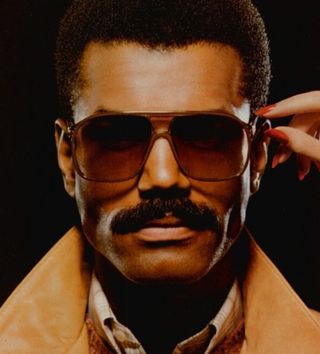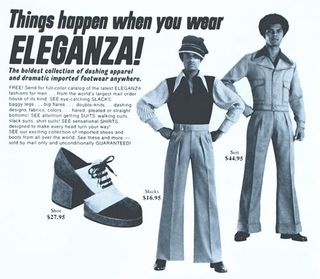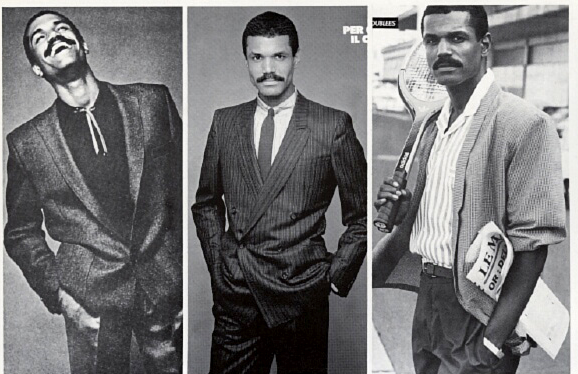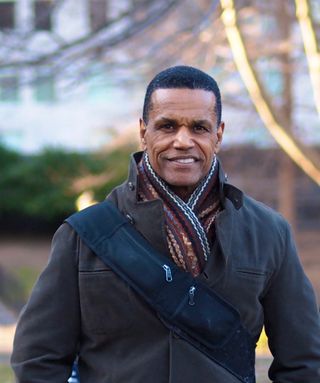
Good Morning POU!
This week we’ll feature pioneers in the fashion industry. It took until the 1970s before African American men began gaining access to modeling jobs with major fashion houses and the opportunity to cover major magazines – and that access did come only after fighting for it.
Renauld White
Renauld White revolutionized the industry by demanding equal representation in mainstream publications. In November 1979, White was the first African-American model to appear on the cover of GQ magazine.
As with most black models during the 60s and 70s – Renauld started with Ebony magazine, doing print ads for the flamboyant Eleganza clothing line that were usually shown in the back pages of the magazine.
According to White, he came to New York from nearby New Jersey one day to demand that agents at Wilhemina models allow more people of color the chance to compete in the industry.
He said, “I wanted to bring about change. I really confronted the establishment about why there were not more black male images. At first I thought I was going to get thrown in jail and beaten up because of my approach. But then they realized that they were wrong and that they were behind society and behind the times, and that they had to listen to me.”
“They offered me a contract because they thought that I would fail. Eventually I proved myself.”
White transitioned out of Eleganza and became an icon of Black cool and sophistication, appearing in a variety of general market ads as the elegant, mustachioed man in control and living the good life.
White went on to not only cover GQ, but also score major campaigns with Black Tie cologne, Vitalis, and Arrows Shirts. He was the first black man to work the runways for Bill Blass, Calvin Klein, Donna Karan, and Ralph Lauren. He also enjoyed success in Europe, where he walked forYves Saint Laurent, Jean Charles de Castelbajac, Cerutti, Valentino, Armani, and Versace.
In 2012, TheTallGuysGearGuide.com interviewed Renauld about his illustrious career:
It must have been a heady time to be a young black model on the move.
Modeling was great, but I didn’t know where it was going to go. There were times that I wanted to rip my portfolio up and throw it out the window. I told my manager that I was getting out of the business and to never call me again.
Why?
Because I was angry! I was Black, and had all of this built up inside. I was living in the east village in a five floor walk up, doing little part time jobs here and there. Nobody discovered me, nobody stopped me on the street and said ‘hey you got a good look’. That didn’t happen for me. I plowed through. I was young, I was awash with the civil rights movement, and I was running with a group of very progressive thinking people.
What was life like before modeling?
I was an overweight kid. I had low self esteem, almost no self esteem. I was weighing about 205 -210, I was about 6’1. It was a process, a physical and mental transition, an awakening…all these things. I thought maybe I’d be an art teacher. But I played football for a year. Never got into basketball, but I wish I would have. But all through high school my buddy Joe and I would always obsess over what we would wear. Joe was a smooth brother. He had it together.
I come from a broken home. I have a mother that’s an angel. I love her to death even now, and she’s been gone for a long time. She just gave me such great tools to carry me through life. The funny thing is that she was a model in Newark. She was beautiful. My dad was tall and handsome, he came out the war and was in Chicago. Someone walked up and gave him a card, and asked him if he’d be interested in modeling. He declined, because he just got out of the army and had to get a job to take care of his family.
Tell me about the GQ cover:
It was a pinnacle in my life. I had been in the business for a decade. I had had other cover tries for GQ and I had been on other covers, Essence twice and various trade magazines. I’d amassed a number of covers but GQ was the ultimate. If you were on the cover, it put you in a whole other stratosphere. It brought you campaigns, and the best of everything in the business.
There were attempts as early as 74-75 to put me on the cover. I’d been working with GQ since 1970. In 1972, I was the first Black model in Men in Vogue. I was getting prestigious work. I want to give props to those other Black models who were there with me, who helped me get through this, and I hope I helped them. A number of them are no longer with us and they made a great contribution to our community and to our people by being positive and uplifting and excited to be a part of a cause. A part of them will always be active and alive in my memory.
Now, Urs Althaus was the first Black model to be on the cover of GQ. Urs was Swiss and Nigerian. It caught everybody off guard. Not like he didn’t deserve it, but he had a hat on, and you really couldn’t tell if he was Middle Eastern or maybe Hispanic, but he was the first Black man to be on the cover.
White later transitioned into the world of theater. He appeared on the soap opera “The Guiding Light,” for many years and now participates in several plays.
His advice for aspiring models is, “We know we have to work…there’s work to be done. I try to talk to as many young people as I can, and encourage them to follow their dreams and to aspire to greater things outside of modeling. Modeling is only a bridge. What are you going to do after modeling is over? I had a 30+ year career, they don’t make those anymore. I encourage them to do amazing things. Take the money, go to school, open up a business, be an entrepreneur, and be self reliant.”
(Information from FashionBombDaily.com and TallGuysGearGuide.com)




